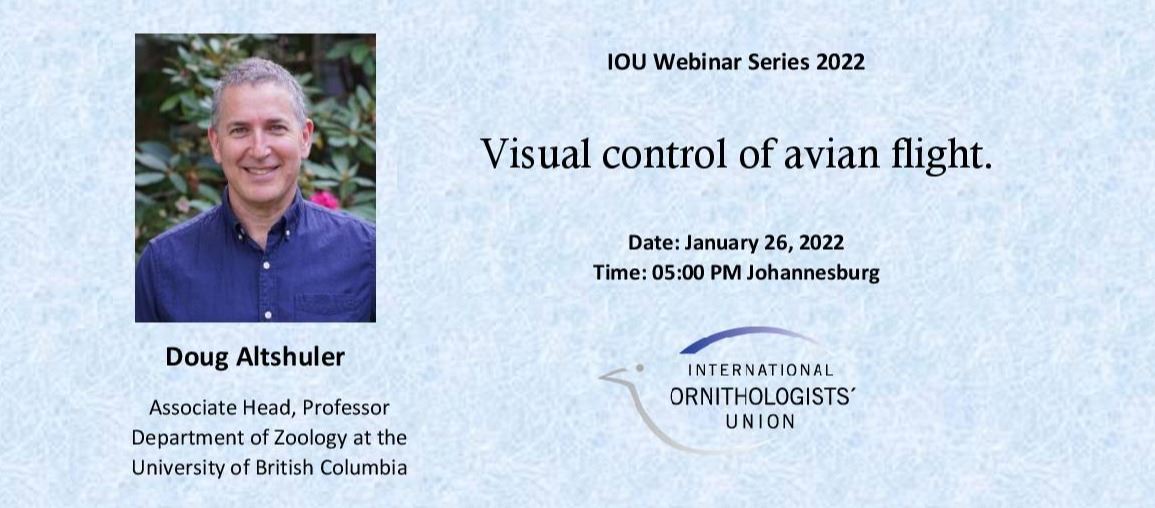IOU webinar series
Branson Ritchie on: "Plasticosis: Is it a ticking health bomb?"
November 21st, 2022
Please watch the webinar video here:
Webinar Description:
Branson Ritchie Distinguished Research Professor University Of Georgia New Materials Institute, United States
Webinar Speaker: Branson W. Ritchie
John Fitzpatrick: Research based on e-bird
March 23, 2022
Please watch the webinar video here:
Webinar Description:
As Executive Director of the Lab from 1995–2021, I oversaw all aspects of the Lab’s affairs and conducted research as a professor in the Department of Ecology and Evolutionary Biology. Since stepping down from the directorship in July 2021, I am still closely involved in Lab affairs, and I am active in a variety of research projects, including my long-term project on the ecology, landscape genetics, and conservation of the Florida Scrub-Jay. I was privileged to grow up in rural Minnesota during the 1950s and 60s, where I fell in love with birds at a very early age. Several of my parents’ friends were birdwatchers, and one was even an avid bird-bander (Jane Olyphant). Our neighbor across the pond was a famous wildlife artist (Francis Lee Jaques) who became my childhood hero. I remain a passionate birder, and occasional bird-painter, to this day.
Webinar Speaker: John Fitzpatrick
(Director Emeritus @The Cornell Lab of Ornithology)
Visual control of avian flight.
January 26, 2022
Doug Altshuler

Please watch the webinar video here:
Webinar Description:
Doug Altshuler first studied world religions with a special emphasis on Vedanta philosophy at UC Santa Cruz (BA, 1992). He spent his third year at the University of Delhi. A field course in Guatemala and Belize sparked a deep passion for organismal biology. Doug's MSc (1996) research from Purdue University examined interactions among plants, birds and insects on Barro Colorado Island in Panama. His PhD (2001) research at the University of Texas at Austin concerned the influence of flight biomechanics on hummingbird foraging ecology and community structure. Lab work in Texas was combined with fieldwork in the Peruvian Andes and the Colorado Rockies. Postdoctoral research (2002-2006) at Caltech focused on aerodynamics and muscle physiology of hummingbirds, zebra finches, and honeybees. Doug has held faculty positions at UC Riverside (2006-2011) and the University of British Columbia (2001-present). Current research concerns the biomechanics and visual control of complex flight behavior.
Webinar Speaker:Doug Altshuler
(Associate Head, Professor @Department of Zoology at the University of British Columbia)
Why do species Multiply
November 4th, 2021
Peter and Rosemary Grant
Please watch the webinar video here:
Webinar Description:
Peter and Rosemary Grant have been studying Darwin’s finches on the Galápagos islands since 1973. The fieldwork is designed to understand the causes of an adaptive radiation. It combines analyses of archipelago-wide patterns of evolution with detailed investigations on two islands, Genovesa and Daphne. By integrating ecology, behavior and genetics, they have revealed how species are reproductively and ecologically isolated, and the causes and evolutionary consequences of rare episodic hybridization. Two mechanisms of speciation have been identified. In collaboration with other investigators, they have estimate phylogenetic relationships among the species of finches and their relatives, identified molecular mechanisms involved in the development of beaks and provided genomic details of evolution in contemporary as well as historical time. The research has been published in many research papers and three books, most recently “How and Why Species Multiply” (2008) and “40 years of Evolution” (2014).
Webinar Speakers:Peter and Rosemary Grant
Peter Grant is the Class of 1877 Professor Emeritus in the Department of Ecology and Evolutionary Biology at Princeton University, having trained at Cambridge University and the University of British Columbia. Before joining Princeton in 1986 he taught at McGill University and the University of Michigan.
Rosemary Grant is Senior Research Scholar Emerita in the same Department. She received her training at Edinburgh University and Uppsala University and taught at Princeton University.
The Barn Owl Replaced the Dove of Peace in the Middle East
August 19, 2021
Prof. em. Yossi Lesham, Prof. Alexander Roulin
Please watch the webinar video here:

 ALEXANDRE ROULIN
ALEXANDRE ROULIN